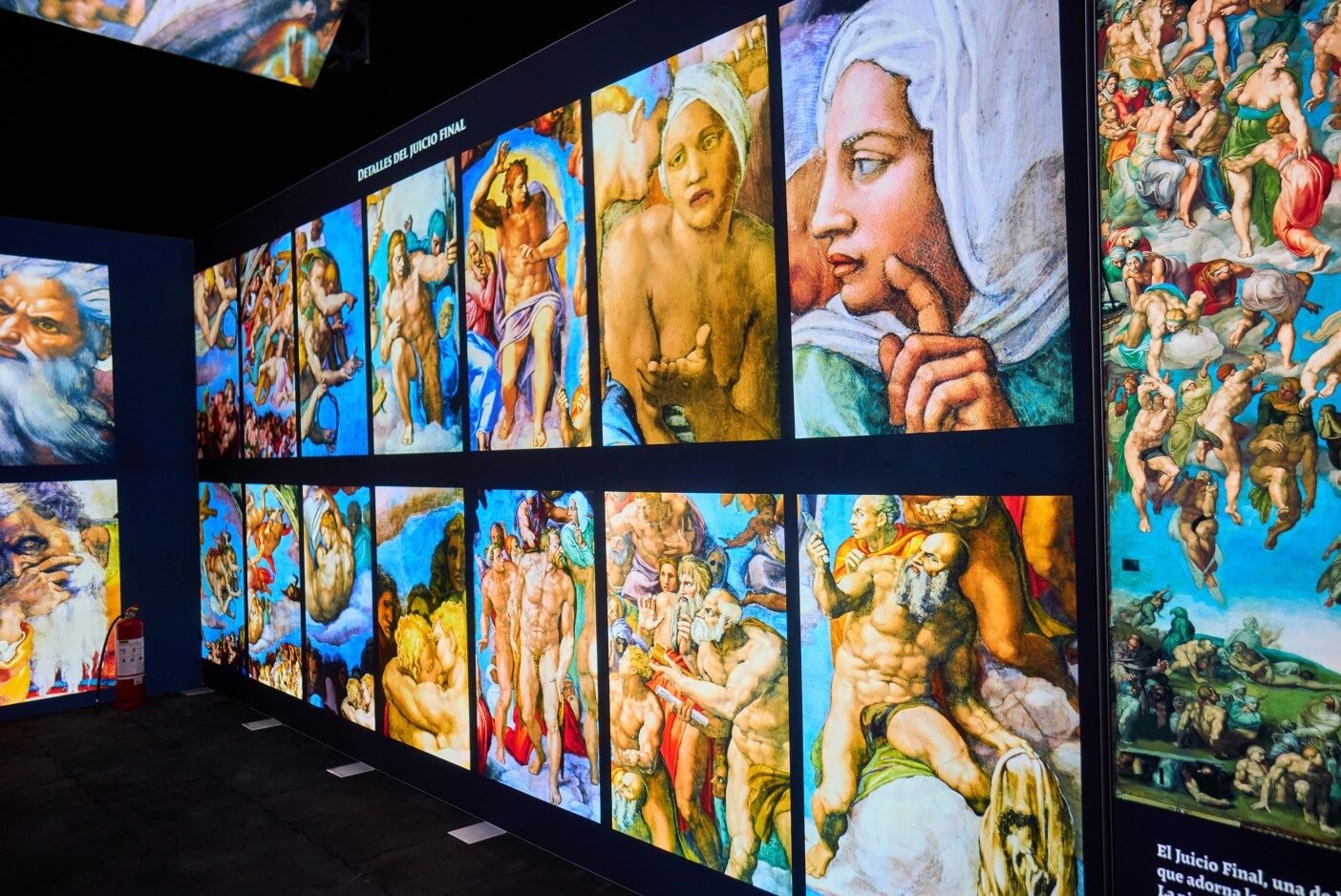Walking into Michelangelo – Art & Legacy is not like entering a typical museum exhibition.
It feels more like crossing a threshold into the artist’s mind — a vast and soaring interior where marble breathes, ceilings speak, and the divine spark is always just a fingertip away.
Presented in the heart of Miami Beach, this exhibition invites visitors into an immersive, full-scale recreation of Michelangelo’s masterpieces. But more than a visual experience, it is an emotional and intellectual journey. It blends high-fidelity reproductions with atmospheric light, sound, and space to offer something rare in today’s cultural landscape: direct, contemplative access to genius.
Sculptures Reimagined — Stillness in Motion
The journey begins with three towering symbols of Michelangelo’s sculptural brilliance: David, Moses, and the Pietà. While these are not the originals, the reproductions are startling in their detail and presence.
Standing before David, viewers are confronted with idealized human strength balanced by inward tension. His muscles may be poised for battle, but his gaze suggests contemplation. This duality — action and thought — is precisely what made the original so revolutionary. The replication captures the same power: it is not just anatomy; it is character carved in stone.
In contrast, the Pietà quiets the room. Mary holding her son’s lifeless body is perhaps one of the most intimate sculptures in history. Seeing it here, life-size and softly lit, you sense Michelangelo’s ability to elevate sorrow into sacred grace. The folds of the Virgin’s robe, the delicacy of Christ’s limbs — all are here, and all feel heartbreakingly real.
Moses, with his muscular forearms and penetrating stare, adds a final dramatic chord. He seems ready to rise from his seat, tablets in hand, impatient with both his flock and fate. In these three statues, the artist’s obsession with motion within stillness becomes clear — his figures never truly rest.
The Ceiling Comes Down to Earth
If the sculptures are a testament to Michelangelo’s ability to shape marble, the re-creation of the Sistine Chapel ceiling reveals his unmatched command of space and narrative.
Here, the viewer doesn’t strain their neck toward a distant fresco. Instead, they walk among and beneath it. The central scenes — The Creation of Adam, The Fall, The Deluge — unfold on every side in large-scale reproductions that are not only faithful, but emotionally charged.
Standing in front of The Creation of Adam, the most iconic of all, is startling. The fingertips nearly touching, the empty space between God and Adam — that electric breath before life is passed — takes on a physical presence in this setting. You don’t just see the image; you feel it across your skin.
The surrounding ignudi — nude male figures Michelangelo added to frame the scenes — showcase his anatomical prowess. Muscular, twisting, full of strange beauty, they remind us that even decoration can carry meaning. They are not angels, not saints, not named — and yet they are unforgettable.
Likewise, the prophets and sibyls that line the outer panels convey psychological depth. Each figure, whether in contemplation or agony, expresses the tension between divine duty and human burden. To see them up close, at eye level, is to meet them in their moment of thought.
A Space That Breathes
What makes Michelangelo – Art & Legacy more than a sum of reproductions is the atmosphere. Soft choral music plays in the background, light shifts across the space to mimic the passing of time, and each room flows intuitively into the next. The effect is one of reverence — not through silence or solemnity, but through intimacy.
Visitors don’t just look at the art. They move with it, around it, and sometimes beneath it. There is no rush, no pressure — only the invitation to take your time. That is, in many ways, the most respectful homage to Michelangelo’s work: the chance to truly observe.
From Observation to Participation
A particularly thoughtful addition is the Creative Lab, where visitors — especially younger ones — can try their hand at artistic creation. Sketching, sculpting, or experimenting with Renaissance techniques, they don’t just admire Michelangelo; they echo him. In doing so, the exhibition offers something no textbook ever could: the physical memory of trying, of doing.
This hands-on element reinforces an essential truth about great art — it is not meant only to be admired. It is meant to awaken.
Why It Matters Now
In our age of digital noise, fast content, and shrinking attention spans, Michelangelo – Art & Legacy offers a kind of cultural reset. It reminds us that true mastery takes time. That beauty can be both sacred and muscular. That art, when shared in the right way, speaks to every generation.
By making these works accessible — geographically, emotionally, and intellectually — the exhibition gives Michelangelo back to the people. Not as an academic subject, but as a living force.
He was, after all, a man of flesh, bone, vision, and fire. And this exhibition, without pretending to replace the originals, manages to rekindle that fire in those who walk its halls.
To see these works, even as replicas, is to understand why they endure. Not because they are marble. But because they are true.
